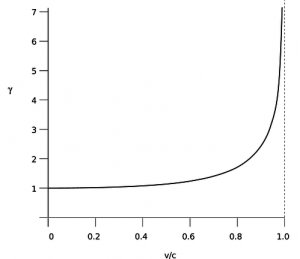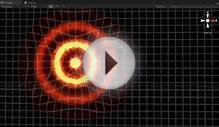
 We are used to thinking of time as absolute and universal, so it is disturbing to find that it can flow at a different rate for observers in different frames of reference. But consider the behavior of the γ factor shown in figure h. The graph is extremely flat at low speeds, and even at 20% of the speed of light, it is difficult to see anything happening to γ. In everyday life, we never experience speeds that are more than a tiny fraction of the speed of light, so this strange strange relativistic effect involving time is extremely small. This makes sense: Newton's laws have already been thoroughly tested by experiments at such speeds, so a new theory like relativity must agree with the old one in their realm of common applicability. This requirement of backwards-compatibility is known as the correspondence principle.
We are used to thinking of time as absolute and universal, so it is disturbing to find that it can flow at a different rate for observers in different frames of reference. But consider the behavior of the γ factor shown in figure h. The graph is extremely flat at low speeds, and even at 20% of the speed of light, it is difficult to see anything happening to γ. In everyday life, we never experience speeds that are more than a tiny fraction of the speed of light, so this strange strange relativistic effect involving time is extremely small. This makes sense: Newton's laws have already been thoroughly tested by experiments at such speeds, so a new theory like relativity must agree with the old one in their realm of common applicability. This requirement of backwards-compatibility is known as the correspondence principle.
h / The behavior of the γ factor.
Space
The speed of light is supposed to be the same in all frames of reference, and a speed is a distance divided by a time. We can't change time without changing distance, since then the speed couldn't come out the same. If time is distorted by a factor of γ, then lengths must also be distorted according to the same ratio. An object in motion appears longest to someone who is at rest with respect to it, and is shortened along the direction of motion as seen by other observers.
No simultaneity
Part of the concept of absolute time was the assumption that it was valid to say things like, “I wonder what my uncle in Beijing is doing right now.” In the nonrelativistic world-view, clocks in Los Angeles and Beijing could be synchronized and stay synchronized, so we could unambiguously define the concept of things happening simultaneously in different places. It is easy to find examples, however, where events that seem to be simultaneous in one frame of reference are not simultaneous in another frame. In figure i, a flash of light is set off in the center of the rocket's cargo hold. According to a passenger on the rocket, the parts of the light traveling forward and backward have equal distances to travel to reach the front and back walls, so they get there simultaneously. But an outside observer who sees the rocket cruising by at high speed will see the flash hit the back wall first, because the wall is rushing up to meet it, and the forward-going part of the flash hit the front wall later, because the wall was running away from it.
i / Different observers don't agree that the flashes of light hit the front and back of the ship simultaneously.
We conclude that simultaneity is not a well-defined concept. This idea may be easier to accept if we compare time with space. Even in plain old Galilean relativity, points in space have no identity of their own: you may think that two events happened at the same point in space, but anyone else in a differently moving frame of reference says they happened at different points in space. For instance, suppose you tap your knuckles on your desk right now, count to five, and then do it again. In your frame of reference, the taps happened at the same location in space, but according to an observer on Mars, your desk was on the surface of a planet hurtling through space at high speed, and the second tap was hundreds of kilometers away from the first.
 Relativity says that time is the same way - both simultaneity and “simulplaceity” are meaningless concepts. Only when the relative velocity of two frames is small compared to the speed of light will observers in those frames agree on the simultaneity of events.
Relativity says that time is the same way - both simultaneity and “simulplaceity” are meaningless concepts. Only when the relative velocity of two frames is small compared to the speed of light will observers in those frames agree on the simultaneity of events.
j / In the garage's frame of reference, 1, the bus is moving, and can fit in the garage. In the bus's frame of reference, the garage is moving, and can't hold the bus.
The garage paradox
One of the most famous of all the so-called relativity paradoxes has to do with our incorrect feeling that simultaneity is well defined. The idea is that one could take a schoolbus and drive it at relativistic speeds into a garage of ordinary size, in which it normally would not fit. Because of the length contraction, the bus would supposedly fit in the garage. The paradox arises when we shut the door and then quickly slam on the brakes of the bus. An observer in the garage's frame of reference will claim that the bus fit in the garage because of its contracted length. The driver, however, will perceive the garage as being contracted and thus even less able to contain the bus. The paradox is resolved when we recognize that the concept of fitting the bus in the garage “all at once” contains a hidden assumption, the assumption that it makes sense to ask whether the front and back of the bus can simultaneously be in the garage. Observers in different frames of reference moving at high relative speeds do not necessarily agree on whether things happen simultaneously. The person in the garage's frame can shut the door at an instant he perceives to be simultaneous with the front bumper's arrival at the back wall of the garage, but the driver would not agree about the simultaneity of these two events, and would perceive the door as having shut long after she plowed through the back wall.
INTERESTING VIDEO











